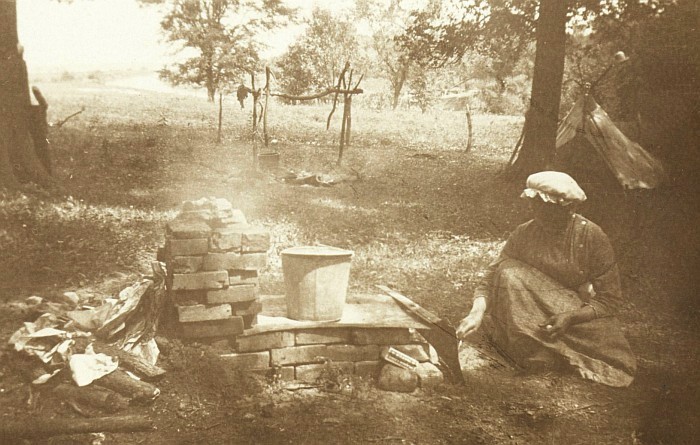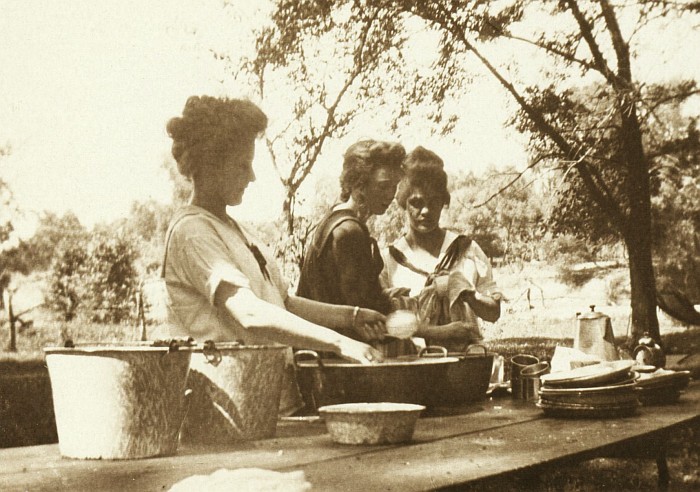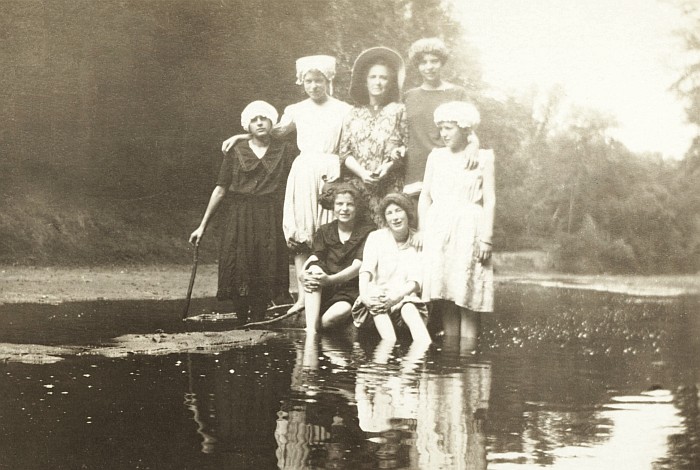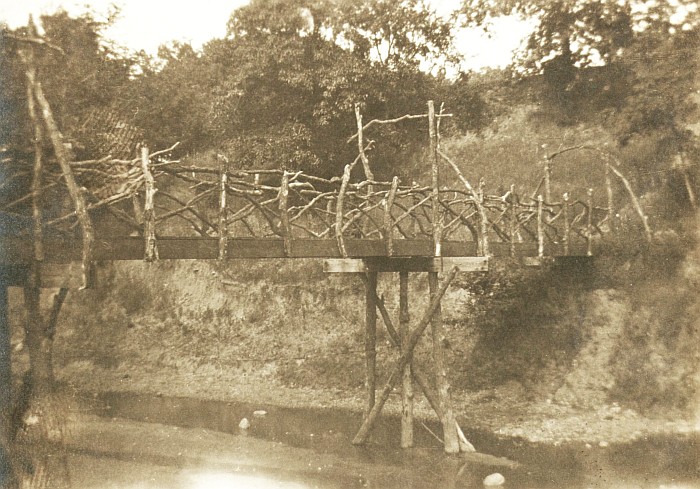This photo from nearly a century ago shows early Camp Fire Girls cooking a meal at a campsite near Ames. Walter Grove would later donate a portion of his land a few miles north of town for a permanent camping facility. To honor Mr. Grove, the site was given the name Camp Canwita, "small grove on top of hill."
From The Story of Camp Fire and of The Heart of the Hawkeye Council, 1910-1985, by Sue Peters, Mary Musgrove, and Marjorie Pohl
The year was 1910 and the time was right. An organization for girls, one of strictly American origin, with a strong American flavor, and emphasizing the needs and interests of American girls, came into being: the Camp Fire Girls. During the early years of the twentieth century, there was an upsurge of interest in programs to benefit children and adolescents. With the flowering of early studies in adult psychology, interest in the psychology of children also grew, and with it came experimental and progressive schools to take advantage of this new knowledge.
Organizations for young people began to spring up, among them the Y.M.C.A. and Y.W.C.A. Many churches developed youth organizations. In 1902, Ernest Thompson Seton, a popular natural history author and artist, founded the Woodcraft Indians for boys. In 1905, Dan Beard, another popular author of books for boys, founded the Society of the Sons of Daniel Boone. In 1908, these men and others joined to found the Boy Scouts of America, incorporated in February, 1910.
There were also camps, some for boys, some for girls. Among those for girls were one operated by Dr. Luther Gulick and his wife, Charlotte Vetter Gulick, at Sebago Lake near South Casco in Maine, and another run by Mrs. Charles Farsnworth at Thetford, Vermont, both founded in 1909.. With all this interest, and with organizations for boys and older youth as well as camps for both boys and girls already operating, the question arose: Why not a nondenominational organization for girls? The time was right; Camp Fire Girls was the result.
In 1910, Dr. Gulick was serving on the organization committee of the Boy Scouts of America and was head of the Department of Child Hygiene at the Russell Sage Foundation, with headquarters in New York. He had been involved in the Y.M.C.A. and had designed its triangular symbol, based on his idea of the characteristics of a whole person -- physical, mental, spiritual. Mrs. Gulick had studied medicine for a year with her husband and was recognized for work in the field of child development...

Mrs. Gulick had consulted with Seton and concluded that the Sebago camp, founded in 1909 with just four campers besides the Gulick family, should base its program on Indian lore and ceremonials. She had also come up with the triad Work-Health-Love, and the name WoHeLo... for the camp, and applied these words to the corners of the triangle Dr. Gulick had developed for the Y.M.C.A., but with one difference: the WoHeLo triangle stood on its base, with the point upward. This triangle, with its sides gently rounded outward, became the original symbol of Camp Fire Girls and has, with modifications, been the basis for more modern logos developed and used during the organization's 75 [now 100] years.
There were seventeen WoHeLo maidens in the summer of 1910... The campers arrived by train in South Casco, Maine, and crossed Lake Sebago by steamer and launch, then faced the tricky job of getting out of the launch carrying their handbags and wearing long, full skirts... At the end of a climb up the rocks, the campers were greeted by Mrs. Gulick and Miss Helen Hunt, who would be their handcraft instructor. Off came the cumbersome long skirts; the campers enjoyed new freedom in bloomers (described as "voluminous") and middies, long black stockings, and tennis shoes. For swimming they wore black bathing dresses with square necks, knee-length skirts -- and no stockings! All this was daring in 1910. Each morning Mrs. Gulick would cry "This is a new day!" and the campers would rise to begin a program quite unlike any there had ever been for girls.
Iowa did play an important part in early Camp Fire history... when in the summer of 1914 Iowa State College, now Iowa State University, was host to the first training course for guardians [Camp Fire leaders] outside of the New York City area - the first national training course. As part of the second summer session ever held there, Iowa State sponsored a Rural Life Conference; both Camp Fire Girls and Boy Scouts took advantage of the opportunity. The Camp Fire Girls conference was June 19 through 26, with Dr. Gulick and his daughter, Francis Gulick, in charge. The Boy Scouts' dates for their Institute were June 22 through 27, with Ernest Thompson Seton in charge. He also took an active part in the Camp Fire Girls' program.
Each afternoon Dr. Gulick would lecture on the meaning of Camp Fire, using the big Agricultural Hall. In 1958, recalling those lectures, Mary Price Roberts of Spirit Lake, one of the Iowans who attended the training session, wrote, "Dr. Gulick led discussions, usually in the evening, usually on the porch of Mohawk House" (a house occupied during the college year by a group of men called the Mohawk Club.) Seton had pitched his tepee at the foot of the hill on which Dean Stanton's house stood; he was in charge of woodcraft, taught some of the guardians how to start fires with "rubbing sticks" (the bow drill), and in the evenings spun yarns about wildlife and the outdoors, usually out under the stars but at least once in the tepee.
The trainees "did most of our handcraft work in the home economics building, swam in the pool in the men's gym, played games in the men's gym or on the campus, heard lectures in the auditorium of Ag. Hall, had many evenings at the foot of the hill..." ... a participant who apparently took part informally, was Bill Gaessler of Ames, who continued to be active in Ames Camp Fire affairs...
Following the Ames training course, there was another at Lake Okoboji. The State University of Iowa catalog for 1914-1915 includes information on a training school for Camp Fire Girls guardians that was scheduled after the end of summer school, in August, 1914, at the Lakeside Laboratory on Lake Okoboji. At that time, the Lakeside Laboratory was operated by the State University of Iowa, but it is now conducted jointly by the University of Iowa and Iowa State University...
By all accounts, the presentations by the Gulicks and Seton were the highlight of the Rural Life Conference. For two weeks, national headquarters of both organizations [Boy Scouts and Camp Fire Girls] were moved to Ames. A large Indian tepee was set up just north of Lake LaVerne, and nightly council fires, including stories, dances, and demonstrations, drew large crowds. During the day, Gulick and Seton conducted training sessions for community leaders and ministers attending the conference. This was the first national guardians' training held anywhere in the United States.
The daytime workshop meetings were held in Curtiss Hall on the campus. Perhaps the most important outcome of this conference for Ames Camp Fire was that a young instructor named Bill Gaessler had an office near where the workshops were being held. Intrigued by the crowds and the excitement, Bill came to the meeting, became interested in Camp Fire, and thus began a 70-year involvement with the organization in Ames. Bill later served as Treasurer of the local council, and as a Vice-President and member of the Board of Directors of the Heart of the Hawkeye Council. His wife Myrtle served as a group leader and Executive Secretary of the Ames Council for many years. The Gaesslers were responsible for founding Camp Canwita in 1925.
Another participant in the training course was Mary Price Roberts, a student at Iowa State College. In the fall of 1914, she received a guardians' certificate and a letter from Dr. Gulick, suggesting that she start a guardians' association. Evidently, she was the leader of a group of college girls.
Aside from the Ames Camp Fire Girls who took part in the 1914 training course, the earliest group for which we have records was formed at Central Junior High School in Ames in the fall of 1916. The leader was Daisy Lee (Hummel), who was also the seventh grade teacher at Central. The group was named "Nualiyi." Members of the group always thought they were the first Camp Fire group in Ames; possibly they were the first group not associated with the college.

Many of the girls stayed in Camp Fire until they graduated from high school in 1922. At the time of their 50th class reunion, in 1972, returning members visited their old leader, Mrs. Hummel, who was still living at that time in Ames. Members of the group included: Melvina Allen (Harpole), Blanch Belknap (Wyllie), June Bishop (Tate), Faye Caul, Alice Clark (McCrillis), Ruth Cooper, Doris Gray (Nystrom), Ila Harris, Elizabeth Hawley, Gladys Knight (Spearing), Ruth McCoy (Doggett), Margaret Matlack (Sabatke), Laura Nelson, Mabel Noble (Montgomery), Rose Roberson, Helen Rodgers (Yancey), Helen Scott (Walsh), Camilla Sorenson (Oberg), and Esther Stenerson (Eschbach). Ruth, Mabel, and Esther still live in Ames and have furnished all of the information about this early group.
The first President of Ames Camp Fire was Margaret Freeman, who served until 1918. Mrs. Daisy Hummel was President from 1918 to 1923. In 1924, an Ames Council was formed. Mrs. L.C. Tilden was first President of the Council, and Mrs. Gaessler was Executive Secretary. Mrs. A.H. Munn became President of the Ames Council in 1928. Other early Council Presidents were Mrs. Charles Reynolds, Mrs. A.H. Fuller, Mrs. Ethel Cessna Morgan, and Lt. Col. Harold Pride. In 1929, Mrs. L.H. Willson, who was principal of a grade school in Ames, became the Executive Secretary of the Council, a position she held until 1945.
Camping has always been an important part of Camp Fire. For the first few years in Ames, local groups camped in area parks and along the Des Moines and Skunk rivers. Ruth Doggett, Mabel Montgomery, and Esther Eschbach remember camping in about 1919 near Table Rock, which is in the Ledges State Park. Another favorite spot for camping in the late teens and early twenties was a log cabin near Ames also used by the Boy Scouts. Ruth and Mabel recall that their group went to this cabin in about 1919, but found the bunk area overrun with snakes. The girls decided they would rather take their chances outside on the ground. Other groups also noted that the cabin was full of bats and mice.
In 1925, Mrs. Bill Gaessler, then Executive Secretary of the Ames Camp Fire organization, became convinced that there was a need for an overnight camp for Ames girls close to the city. President Mrs. L.C. Tilden appointed Mrs. Gaessler to chair a committee consisting of Mrs. J.C. Cunningham, Mrs. I.J. Scott, and Prof. C.S. Nichols, to find a camp site. After a search of the surrounding area, they located a suitable plot of ground north of Ames, near Highway 69. The owner, Walter Grove, was willing to let the girls use his land, and that year the girls camped in tents in a fenced-in area of the pasture, among the cows. This first camp was called Camp Grove.
The next year, the Gaesslers located a new site on a bluff above the Skunk River east of the first spot. Mr. Grove approved of the move, and a local contractor estimated a cabin could be built for about $1,000. A fund drive was begun with the cooperation of Bates Bakery. The girls sold doughnuts door to door; in three sales they raised $377.00. The council borrowed the rest, and in the summer of 1926, Charles Allen built the first lodge at the cost of $1,100. At this time the camp name was changed to "Canwita," an Indian name meaning "Small grove on top of hill," in honor of Mr. Grove.
The girls began camping in the new building in the fall of 1926. An ad in the Ames newspaper for used furniture resulted in enough cast-offs to supply them with dishpans, curtains, dishes, and cooking pans. At first the girls slept on bags stuffed with straw until the Kiwanis Club donated cots and mattresses. Members continued their fund-raising efforts, giving talks and bread and milk luncheons to service clubs. A fourth sale of cookies netted another $170.00. Community organizations donated lumber and labor for tables and cement for stoops and fireplaces, which the Boy Scouts helped to build. The Forestry Department of Iowa State College donated shrubbery and trees, and each group of girls was assigned responsibility for taking care of one of the trees. Finally in March of 1928, following yet another cookie and doughnut sale, the last payment was made on the lodge and Canwita belonged to Camp Fire. Mr. Grove never received any money for the land he so generously made available. He left the land on which Canwita is built to Camp Fire as long as the organization continues to exist. He gave the neighboring land to the city of Ames for a park, named in honor of his wife, Inis Grove...
When Camp Canwita was begun, it was a small camp site several miles from Ames in the middle of Iowa farmland. Now it is located along busy Duff Avenue, just adjacent to a city park, and only half a mile from a shopping center. But Canwita remains what Myrtle and Bill Gaessler dreamed of -- a piece of wilderness where Camp Fire members can nourish their love for nature, and the heart of Ames Camp Fire.
History of the Heart of Iowa Council, Camp Fire USA





